Peter Hancock, 1 Jody Dunstan, 1 Keith Hall, 2 Gareth Harriman 3
1 Waters Corporation (Manchester, UK)
2Hall Analytical Laboratories Ltd., (Manchester, UK)
3GHGeoChem Ltd., (Liverpool, UK)
Universal application advantages <br> ionization source can promote APGC, UPLC ®, or UPC 2TM conveniently implemented in combination with fast MS on the same platform. APGC is a soft ionization technique that produces a smaller amount of fragment ions than conventional EI. Clearly identify the sedimentary environment of the reservoir.
Waters solution <br> atmospheric gas chromatography (the APGC)
Xevo ® TQ-S
MassLynx ® software
Keywords <br> oil, biomarkers, quadrupole, MRM, APGC, alkoxy steroids, hopanes
About <br> oil exploration and oilfield development depends largely on the awareness and use of crude oil and hydrocarbon source rocks "biomarkers" to address the source on the oil and gas, storage issues and the evolution of history. These "biomarkers" are molecular fossils that are stable under geological conditions. They are also equivalent to the "DNA" of petroleum, which not only provides information on the biological origin of petroleum, but also provides information on the sedimentary environment of the parent material and the thermal evolution history of the buried organic matter. This information has many uses, especially in upstream applications, and ultimately can link specific geographic locations to economic productivity. Since hydrocarbon compounds have not been exposed to the atmosphere (and degradation) or high temperature environments, biomarkers are stable throughout the geological period. They provide a powerful tool for the study of fingerprints of petroleum and source rocks, and are important for the connection between petroleum and petroleum and its parent source rocks.
Oil may come from a variety of sources, mainly from organic matter deposited in continental or aqueous environments. Terrestrial oil comes from substances derived from terrestrial plants, such as coal and resins. The biomarker will reflect this information with double juniper, indicating the input of the resin, while other biomarkers such as oleanane and lupin are associated with flowering plants. The aqueous environment of petroleum includes marine organic matter or lakes (lake environments) contained in shale, carbonate and evaporite. Among them, the biomarker will reflect the source organic matter input and the mineral composition of the source rock. For example, 24-n-propylcholestane (C30 decane) is found throughout the marine environment but not in lake or terrestrial-derived petroleum. Similarly, a large amount of gamma waxes indicate that the source rocks of petroleum are deposited in a highly salinity environment.
experiment
Sample Preparation <br> with an excess of n-heptane to precipitate the oil sample, wherein the asphaltenes removed.
<br> GC conditions System: Agilent 7890 and 7683B Autosampler Column: Restek Rxi-5Sil MS 30 m 0.25 mm, 0.25 m
Carrier gas: helium, 1 mL/min
Temperature program: Hold at 20 ÌŠC for 2 min at 10 ÌŠC/min to 180 ÌŠC, increase to 315 ÌŠC at 2.5 ÌŠC/min for 11 min
Inlet temperature: 300 ÌŠC
Injection mode: 1 μL, no split, 1.5 min vent gas: nitrogen, 400 mL/min Transmission line temperature: 350 ̊C
MS conditions <br> system: Xevo TQ-S
Ionization source: APGC
Corona needle current: 2 μA
Ionization source compensation: 50 V
Source temperature: 150 ÌŠC
Cone gas: Nitrogen, 150 L/hr
Auxiliary gas: nitrogen, 300 L/hr
Acquisition mode: Multiple Reaction Monitoring (MRM)
Biomarkers are low in petroleum and are often masked by higher levels of n-alkanes. Although petroleum can be combined with an electron impact ion source (EI) by gas chromatography-mass spectrometry (GC-MS) for routine analysis in a selective ion scan mode, it is usually necessary to separate it into a saturated hydrocarbon fraction and an aromatic hydrocarbon prior to analysis. Distillate. Even so, if the n-alkane is higher in the range of C25 to C35 (the biomarker elutes in this region), then the n-alkane needs to be removed to
The biomarkers are preconcentrated. The mass spectra obtained from these analyses, decane m/z 217, decane m/z 191 were used in the geochemical evaluation of petroleum. Although these analytical methods are very effective, the target biomarker content is too low (C26 and C30 decane) or multiple markers are co-eluted (if the abundance of decane is much higher than decane, then the identification of decane will be Very difficult) and some information is lost. Due to the complexity of the samples and the relatively low biomarker content, gas chromatography-tandem mass spectrometry (GC-MS/MS) analysis is often required to solve specific geochemical problems. C30 decane is abundant in marine oil sources. However, the marker content is low and co-elutes with 4-methyl decane, which means that it can only be accurately detected and quantified using MS/MS.
Just as MS/MS has been shown to improve the mass spectrometric measurements of these compounds, the use of atmospheric piezoelectric ionation represents an advantage over EI. Atmospheric pressure gas chromatography (APGC) produces molecular ions M•+, but its relative abundance is much higher than in EI mode. This increases the selectivity of the first stage of MS and transports high abundance of molecular ions to the collision cell to achieve controlled fragmentation during MS/MS analysis. In contrast, only fixed fragment ions and low abundance of molecular ions can be generated in EI mode. Since EI and APGC use the same form of molecular ion mode under charge exchange conditions, MRM transitions for APGC-MS/MS and GC-MS/MS are also beneficial for correlating historical data with results obtained using this new approach. Union. In this application note, we report a new analytical technique for the analysis of petroleum biomarkers in source rocks and crude oils by the APGC-MS/MS method.
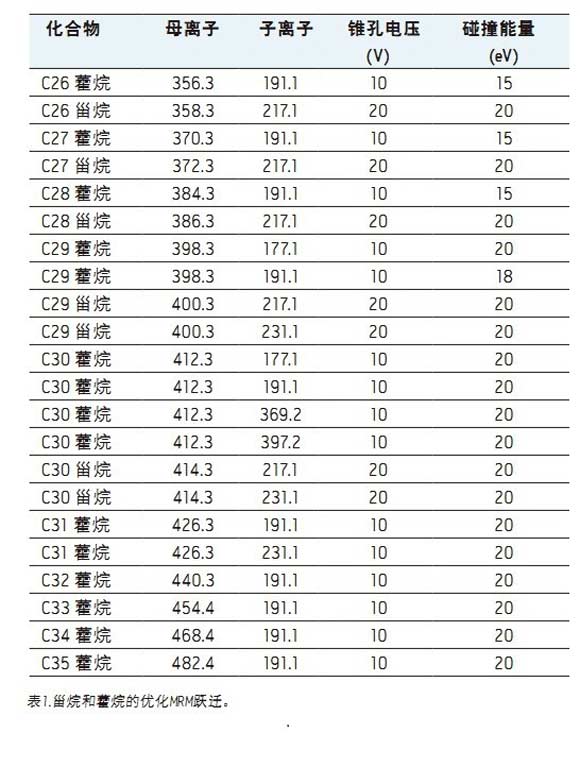
Results and discussion <br> employed APGC ionization and atmospheric pressure chemical ionization (APCI) are similar in that both molecular ions can be generated. APGC is a "soft" ionization technique that produces fewer fragments. The presence of strong molecular ion peaks provides ideal conditions for MS/MS analysis.
Figure 1 shows the comparison of APGC mass spectrometry and EI mass spectrum of C30 pentacyclic trioxane in marine crude oil. A large number of low mass fragments can be obtained in EI mode. This results in fewer parent ions for the MRM transition and reduced selectivity. If the molecular ion peak is selected as the parent ion, the sensitivity is lowered. The fragments observed in the APGC mode were less and the molecular ion peak was the base peak. When performing MRM analysis, obtaining high-intensity parent ions is critical to reducing detection limits.
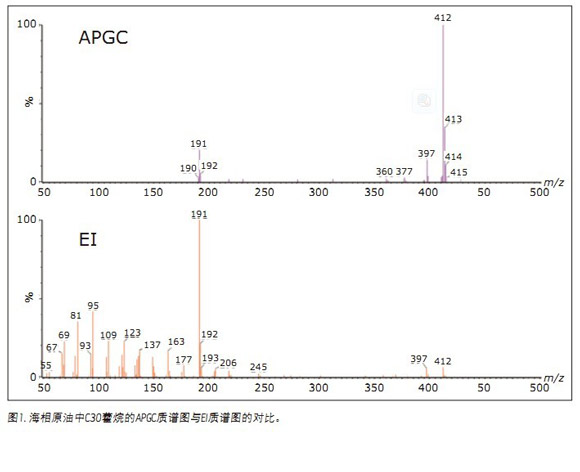
The low biomarker content of high maturity oil requires the use of high sensitivity and high selectivity mass spectrometry to characterize and quantify such oil. Figure 2 shows typical MS fragments of decane and decane. MS/MS reduces matrix interference, allowing geochemists to monitor specific parent-ion-ion transitions and obtain information that GC-MS cannot obtain in SIR mode. Figure 3 shows the elution regions of C26 and C30 decane, revealing the problems associated with these low abundance components associated with co-elution of C27-C29 decane in SIR mode using GC-MS.
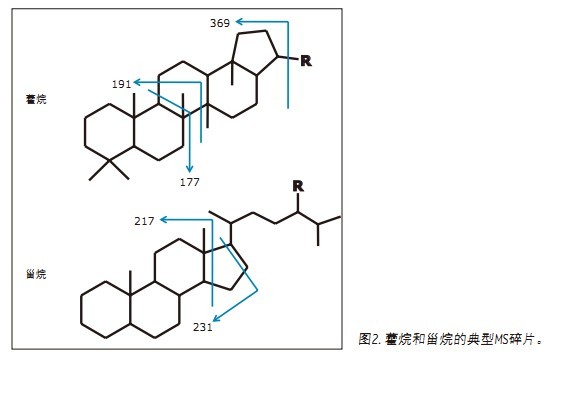
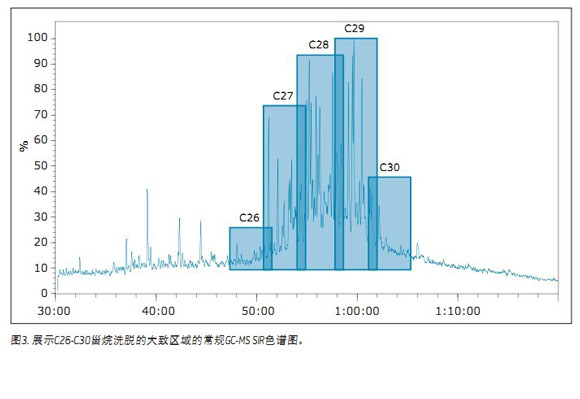
One of the most common applications of GC-MS/MS in the analysis of biomarkers is the detection and quantification of decane. The results obtained can define the following aspects:
1. Determine whether the oil is derived from the marine or non-marine phase by assessing the presence or absence of C30 decane.
2. Determine the age of the oil-producing source rock by assessing the ratio of C28/C29 decane and C26 decane.
The example shown in Figure 4 is the British North Sea oil derived from the Jurassic marine source rocks. By analyzing in MS/MS mode, geochemists can not only confirm their marine origin (the presence of C30 decane), but also pass the C28/C29 decane ratio (0.41) and 24-reduced cholesterane or NDR. The ratio (peak 1+2/1+2+3+4=0.2) confirms that the oil is from the Jurassic source rock. The selectivity of MS/MS makes quantification easier because there is no co-elution between the components.

Figure 5 shows the decane and decane GC-MS SIR data for the blended petroleum from Côte d'Ivoire. The oil contained in the stacked reservoirs is derived from source rocks deposited under marine conditions, but is also significantly affected by terrestrial organic matter. Biomarker detection based on these data first provided an explanation for the terrestrial source of petroleum, as the large amount of markers contained in the oil indicates that the parent source rock is in the sedimentary environment of the river and lake delta. These markers include oleanane (derived from higher plants) and abundant C29 decane (derived from terrestrial plants). C30 decane can only be identified by APGC-MS/MS. The results are shown in Figure 6, confirming the impact of the marine environment on the petroleum parent source rocks.
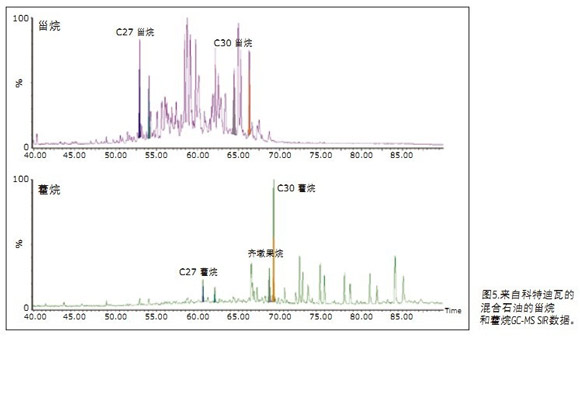
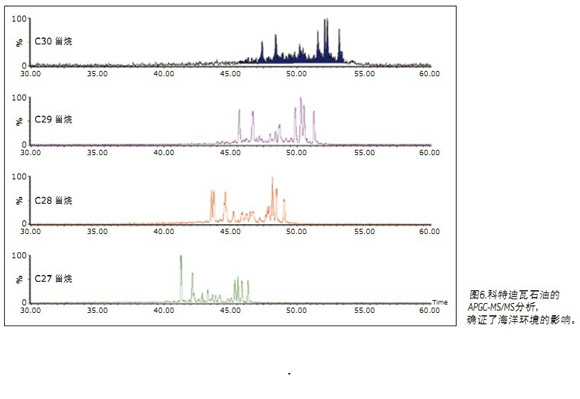
Non-polar GC columns are widely used in petroleum biomarker GC-MS analysis, and peak elution before C30 decane is obtained from this column, usually identified as oleanane. The parent ion of oleanane (m/z 412) is the same as C30 decane, but remains weaker. However, lupinane has the same mass number and very similar mass spectrum as oleanane, except that it has a m/z 369 product ion. Little is known about the importance of lupin as a geochemical marker, in large part because it is often referred to as olean. These compounds can be sufficiently separated by reversed-phase HPLC, but if a single analytical system is desired, APGC-MS/MS is preferred, which determines whether the peak eluted before C30 decane is oleanane or lupinane. . Figure 7 shows an example of a fraction having a peak flowing out before C30 decane. By monitoring the second transition, we can easily see that there is no peak out at the same retention time. This indicates that the analysis sample contained only oleanane and did not contain lupin.
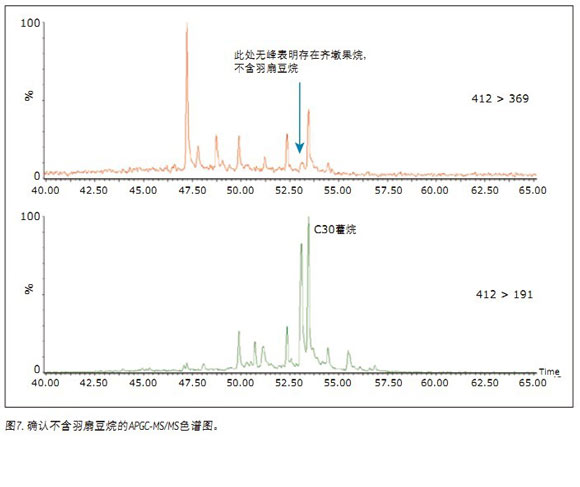
in conclusion
APGC is a soft ionization technique that produces fewer fragment ions than conventional EI. APGC operates under dry conditions and usually produces a mass spectrum of strong free radical cation molecular ion peaks, which facilitates direct comparison with EI databases from different sources. The richness of these ions and the MRM transition mode contribute to the specificity and sensitivity of petroleum biomarkers, providing information on the bio-sources of the petroleum, the depositional environment of the parent organic matter, and the thermal evolution history of the buried organic matter. This information is very useful in upstream applications and can ultimately correlate specific geographic locations with economic productivity.
All Waters instruments are equipped with a universal ionization source that facilitates the quick and easy combination of APGC, UPLC or UPC 2 on the same MS platform. When combined with Xevo TQ-S, APGC can quantify low levels of petroleum biomarkers to clearly identify the reservoir's depositional environment, which is difficult to achieve for GC-MS systems.
references
1. AG Holba, LIP Dzou, WD Masterson, WB Hughes, B Huizinga, MM Singletary, M Moldowan, MR Mello, and EW Tegelaar. (1998). Application of 24-norcholestanes for constraining source age of petroleum. In: Advances in Organic Geochemistry 1997. Proceedings of the 18th International Meeting, Maastricht NL. September 22-26. Vol. Part II Biogeochemistry, Pergamon Press & EAOG pp. 1269-1284: Org. Geochem V.29 Nos. 5/7.
2. HP Nytoft, A Jorgen, B Koefoed, FG Christiansen, MG Fowler. Oleanane or Lupane? Reappraisal of the presence of oleanane in Cretaceous-Tertiary oils and sediments. In: Org. Geochem 33: 1225-1240, 2002.
3. KE Peters, CC Walters, JM Moldowan. The Biomarker Guide. Cambridge University Press ISBN: 0 521 83763 4, 2005.
Download the full PDF document: http://?lid=134730757&cid=134528340&locale=zh_CN
Baby Octopus
Baby Octopus
ZHEJIANG EVERNEW SEAFOOD CO.,LTD , https://www.evernewseafood.com